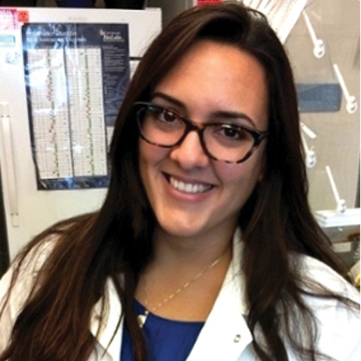 Members of NSU’s Halmos College of Natural Sciences and Oceanography—including a student, alumna, and faculty—have published a paper online in the journal ACS Synthetic Biology.
Members of NSU’s Halmos College of Natural Sciences and Oceanography—including a student, alumna, and faculty—have published a paper online in the journal ACS Synthetic Biology.
 Alumna Olena R. Bracho (B.S. in Biology, 2015) and biology major Cyril Manchery were cited as the lead authors of the paper titled “Circumvention of Learning Increases Intoxication Efficacy of Nematicidal Engineered Bacteria.”
Alumna Olena R. Bracho (B.S. in Biology, 2015) and biology major Cyril Manchery were cited as the lead authors of the paper titled “Circumvention of Learning Increases Intoxication Efficacy of Nematicidal Engineered Bacteria.”
College faculty members Evan Haskell, Ph.D., professor; Christopher Blanar, Ph.D., assistant professor; and Robert Smith, Ph.D., assistant professor, co-authored the article. Their areas of expertise include mathematical modeling and simulation (Haskell), parasitology (Blanar), and synthetic biology (Smith, senior author). Bracho and Manchery’s undergraduate research focused on engineering bacteria that both attract and intoxicate the model nematode, Caenorhabditis elegans.
“Within the scope of our paper, one of the long-term goals of the research is to create engineered bacteria that could be used to prevent or combat disease by preferentially intoxicating certain nematode species,” Manchery said.
Parasitic worms are one of the most widespread infectious agents on earth. Despite their prevalence, the options to prevent infections from these worms remains relatively limited, according to the study. As a potential mechanism to treat or prevent such infections, the researchers engineered bacteria using synthetic biology to both attract and kill the model nematode, C. elegans.
While the attraction and killing process were efficacious when implemented separately, the simultaneous activation of both was shown to drive aversive learning in C. elegans, which reduced killing efficacy. Guided by mathematical modeling, the study’s authors were able to circumvent learning by decoupling the attraction and killing processes.
“The results from this paper form the foundation for a new potential method to prevent infection with nematodes and highlight the importance of understanding the dynamic relationship between synthetic systems to treat infection diseases and their target pathogen,” Smith said.

